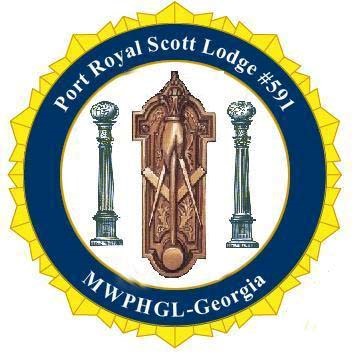HISTORY OF PRINCE HALL TO FREEMASONRY IN GEORGIA
.
On March 6, 1775, Prince Hall and 14 men of color were made masons in Lodge #441 of the Irish Registry attached to the 38th British Foot Infantry at Castle William Island in Boston Harbor, Massachusetts. It marked the first time that Black men were made masons in America.
About a year later, since the conflict between England and America had commenced, the British Foot Infantry left Boston, along with its lodge, leaving Prince Hall and his associates without a lodge. Before the lodge left, Worshipful Master Bait gave them a “permit” to meet as a lodge and bury their dead in manner and form. This permit, however, did not allow them to do any “Masonic work” or to take in any new members.
Under it, African Lodge was organized on July 3, 1776, with Prince Hall as the Worshipful Master. It wasn’t long before this lodge received an additional “permit” from Provincial Grand Master John Rowe to walk in procession on St. John’s Day.
On March 2, 1784, African Lodge #1 petitioned the Grand Lodge of England, the Premier or Mother Grand Lodge of the world, for a warrant (or charter), to organize a regular Masonic lodge, with all the rights and privileges thereunto prescribed.
The Grand Lodge of England issued a charter on September 29, 1784 to African Lodge #459, the first lodge of Blacks in America.


Even though there was the smell of gunpowder and the echoing of cannons of the civil war, the fight for freedom and the great struggle of the North and the South were ongoing. The formation of a Masonic Lodge was on the minds of men of color for many years. At that time colored men were not allowed to have any gatherings what so ever except for religious purposes. Immediately after President Lincoln issued the Emancipation Proclamation, the brethren who were interested in the formation of a Lodge started to hold meetings. Several attempts were made to establish a Lodge but it was very difficult to secure the required number of Masons to assist in the work. The work was, therefore delayed. At the close of the Civil War in 1865, Masonic Lodges began to appear in the Southern States.
Rev. James M. Simms, a Baptist minister and a free man from Savannah, Georgia, had moved to Boston, Massachusetts where he was made a Mason. As soon as the Civil War ended, Rev. James M. Simms, clothed with Masonic authority as a District Deputy Grand Master, returned to Savannah to live. Finally a dispensation was granted by the Prince Hall Grand Lodge of Massachusetts on February 4 A.D. 1866, A.L. 5866 and Eureka No. 11 A.F. & A. M was organized. The first Lodge room was located in the building which today occupies the site of the Chatham Bank and Trust Company located west of Johnson Square.
Bro. James M. Simms was appointed District Deputy Grand Master for the area, which covered Georgia, Florida, and Alabama. The Prince Hall Grand Lodge of Massachusetts granted the Charter for Eureka No. 11 A. F. & A. M. on 24 June 1866. At its inception, the Lodge grew to such a large number that some of the brethren were given their demits so that in September of the same year John T. Hilton Lodge No.13 in Savannah could be formed being granted a dispensation by the Prince Hall Grand Lodge of Massachusetts. Bro. James Jackson helped to organize Banneker Lodge No. 38 in Augusta, Georgia. The Grand Lodge of Pennsylvania granted the dispensation.
District Deputy Grand Master Simms called these three Lodges together to meet in Savannah and following the customs and Landmarks of Freemasonry, DDGM Simms established on 22 August 1870 the Most Worshipful Grand Lodge of Free and Accepted Masons for the State of Georgia. Eureka No. 11 became Eureka No. 1, Hilton No. 13 became Hilton No. 2 and Banneker No. 38 became Banneker No. 3. The first 16 lodges established by this Grand Lodge are as follows:
- Eureka Lodge #1 – Savannah
- Hilton Lodge #2 – Savannah
- Banneker Lodge #3 – Augusta
- Bradwell Lodge #4 – Columbus
- St. James Lodge #5 – Atlanta
- James M. Simms Lodge #6 – Darien
- St. John’s Lodge #7 – Americus
- St. Matthews Lodge #8 – Eufala, Alabama
- Louis B. Toomer Lodge #9 – Brunswick
- Summner Lodge #10 – Blackshear
- Zion Lodge #11 – St. Mary’s
- Mount Moriah Lodge #12 – Key West, Florida
- Phoenix Lodge #13 – Macon
- Pythagoras Lodge #14 – Savannah
- King Solomon Lodge #15 – Albany
- Mount Moriah Lodge #16 – Savannah

- James M. Simms | 1870 -1872
- Louis B. Toomer | 1872 -1874
- John H. Deveaux |1874 -1883
- Alexander Harris |1883 -1886
- Anthony K. Desverney | 1886 -1888
- William E. Terry | 1888 -1889
- John D. Campbell | 1889 -1894
- William E. Terry | 1894 -1901*
- Henry R. Butler, M.D. | 1901 -1932*
- John W. Dobbs | 1932 -1962*
- Xenophon L. Neal, Ph. D | 1962 -1990
- Neal McQueen | 1990 -1995
- Benjamin P. Barksdale | 1995 -2000
- Willie L. Williams | 2000 -2005
- Ramsey Davis, Jr. | 2005 – 2010
- Douglas M. Jones | 2010 – 2014
- Bruce A. James | 2014 – 2019
- Corey D. Shackleford, Sr. | 2019 – 2022
- Primus T. James | 2022 – present

